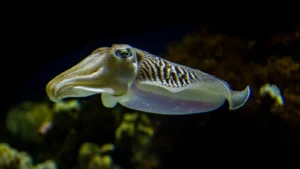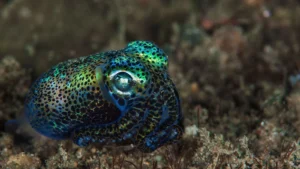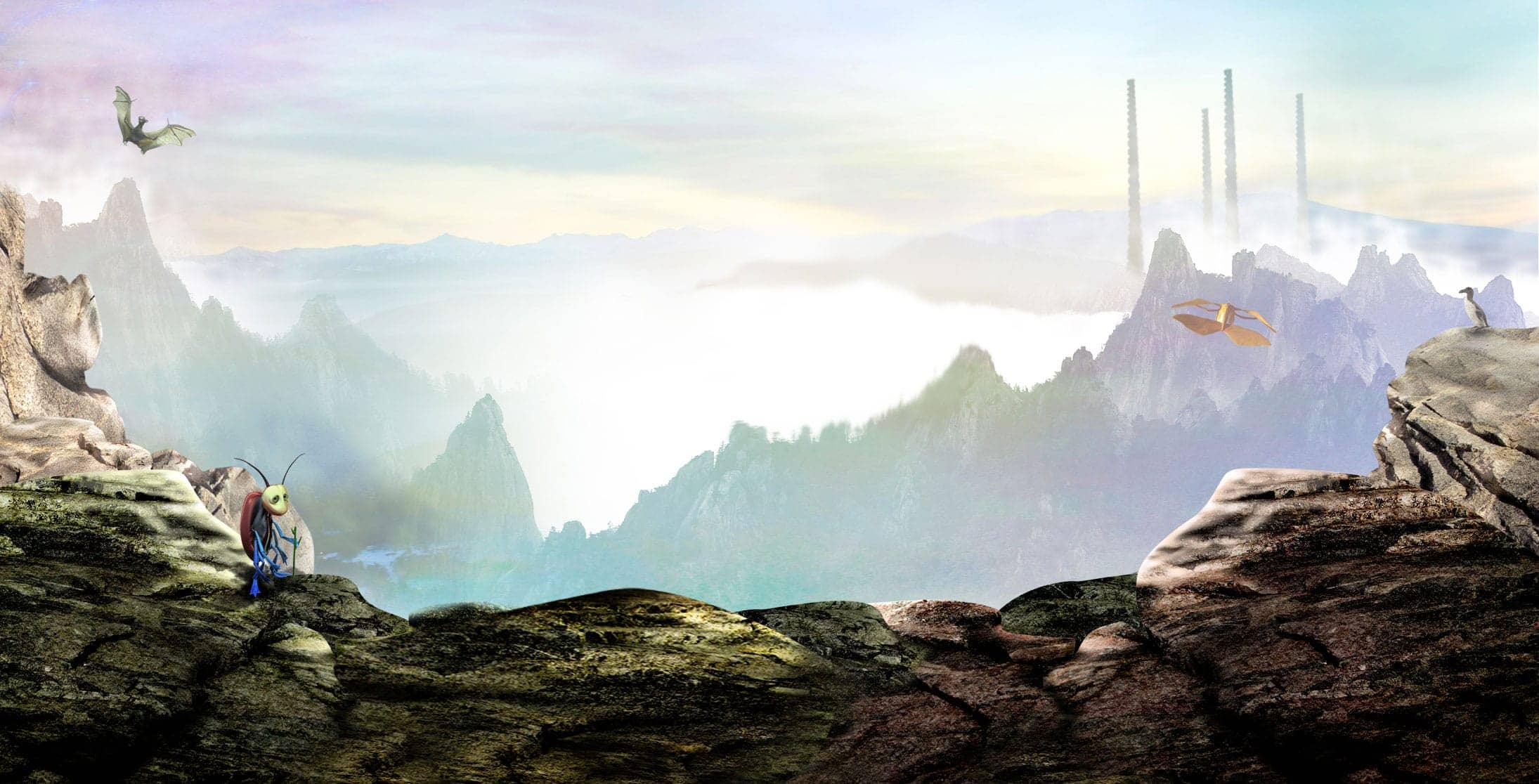After celebrating World Octopus Day and Nautilus Night, International Cephalopod Awareness Days Continue. We now meet the ocean’s shapeshifters, the squid and cuttlefish, and the mythical Kraken that still haunts old sea stories.
These extraordinary creatures combine science and mystery, showing us how flexible, creative, and intelligent life can be beneath the waves.
⚡ The Fastest Tentacles in the Sea
Squid are the jet engines of the ocean. They move by shooting water through a siphon, gliding and darting through the depths with astonishing speed. The Humboldt squid, sometimes called the “red devil,” can reach speeds of up to 25 miles per hour and communicate using flashes of colour across its skin.
Cuttlefish, meanwhile, have the most advanced camouflage system known. They can copy colours and textures around them in an instant, even though they cannot see colour as we do. Their skin becomes a living pattern, shifting with every pulse of light.

A Pharaoh Cuttlefish
🧬 Cuttlefish: The Masters of Mind Control
Scientists have discovered that cuttlefish are capable of remarkable learning and memory. They can recall specific experiences for years and even appear to dream. When asleep, their skin flickers through patterns and colours, echoing the way our eyes move during deep sleep.
They also show self-control. In a test similar to the famous “marshmallow experiment,” cuttlefish learned to wait for a better reward rather than taking a smaller one immediately. This level of intelligence challenges how we think about invertebrate minds.
🌌 The Real-Life Inspiration for the Kraken
Long before anyone saw a giant squid alive, sailors told stories of monsters dragging ships beneath the waves. Those legends became the myth of the Kraken.
When scientists finally filmed a giant squid in its natural habitat in 2012, they found truth within the myth. The giant squid (Architeuthis dux) can grow to over 13 metres in length, with eyes the size of dinner plates. In the darkest oceans, its enormous arms and glowing body must have looked terrifying to early sailors.

A Bobtail Squid
Biomimicry: What Squid and Cuttlefish Are Teaching Us
Squid and cuttlefish are not only extraordinary animals; they are also shaping the future of design and technology. Their skin is made up of several specialised layers. Chromatophores expand and contract to control pigment, while iridophores and leucophores reflect and scatter light. Together they create colour, pattern, and texture that can change in less than a second.
Researchers are using these biological blueprints to develop smart materials that adapt to their surroundings in the same way. At the University of California, Irvine, scientists have created flexible films that shift how they reflect heat when stretched. This could lead to clothing that regulates temperature, packaging that self-insulates, and energy-saving surfaces that react to weather.
At the University of Nebraska–Lincoln, engineers are building synthetic skins that copy how cephalopods control colour and movement. These materials could transform soft robotics, wearable technology, and next-generation displays.
Other researchers have produced stretchable camouflage sheets that raise or flatten tiny 3D bumps to imitate textures like coral or seaweed. Some teams are even studying squid teeth proteins to create self-healing coatings and materials that repair themselves underwater.
By following nature’s designs, scientists are learning how to build systems that are flexible, efficient, and sustainable. At Rockford’s Rock Opera, this connection between biology and creativity lies at the heart of our stories. Evolution has been refining solutions for billions of years, and the ocean holds some of the most ingenious examples.
🦑 Colonel Utensil and the Extinct Squid Squad
In Lost on Infinity, we meet Colonel Utensil, a ten-legged Dectopus who leads the Extinct Squid Squad in the waters around the Island of Infinity. They are guardians of lost species and keepers of time. When new arrivals appear, they guide them to Infinity Beach, where every story begins again.
Much like the real cephalopods that inspired him, Colonel Utensil embodies nature’s creativity and resilience. Scientists studying squid and cuttlefish are learning from these same qualities to design new materials and technologies that imitate life’s natural intelligence. You can read more about this fascinating research in the article from World Bio Markets.
🌍 Why Squid and Cuttlefish Matter
Squid and cuttlefish are vital to marine food webs, supporting whales, dolphins, and large fish. They are also key indicators of changing oceans. Their numbers rise and fall rapidly as water temperatures shift, offering clues about the impact of climate change.
Protecting them protects the balance of the seas and ensures that the world’s greatest shapeshifters continue to inspire art, science, and storytelling.
🐙꩜🦑🐙꩜🦑🐙꩜🦑🐙꩜🦑🐙꩜🦑🐙꩜🦑🐙꩜🦑🐙꩜🦑🐙꩜🦑
Discover more through story and song
At Rockford’s Rock Opera, we believe nature’s resilience can inspire both science and imagination. Our story Lost on Infinity explores extinction, biomimicry, and the secrets of the natural world through an unforgettable musical adventure. In Lost on Infinity, we meet Colonel Utensil, the ten-legged Dectopus who leads the Extinct Squid Squad, guardians of the past who carry messages of hope for the future.
Get the Lost on Infinity illustrated book with free musical audiobook – a totally immersive experience.
Listen to the first part of the Lost on Infinity audiobook and watch the animated adventure free on Apple App Store and Google Play.
Download our FREE lesson plans and slides about Extinction and Biomimicry. We also have a selection of classroom activities on our website.
For even more exploration of the natural world, tune in to our Stories, Science & Secrets podcast for kids. Join Matthew, Elaine, Steve Punt and special guests, as we delve into the fascinating world of biomimicry and the inspiring ways science learns from nature’s genius.
Biomimicry (learning from nature) is a fascinating classroom topic. You can read more about biomimicry and see all the discoveries we have documented in our Creatures’ Secrets Database.

